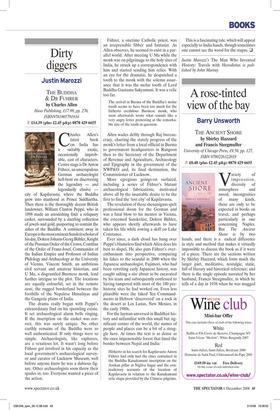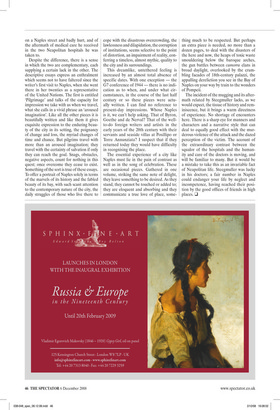A rose-tinted view of the bay
Barry Unsworth
THE ANCIENT SHORE by Shirley Hazzard and Francis Steegmuller University of Chicago Press, £9.50, pp. 127, ISBN 9780226322018 ✆ £8.40 (plus £2.45 p&p) 0870 429 6655 Variety of impression, diversity of atmosphere and mood, incongruities of many kinds, these are only to be expected in books on travel, and perhaps particularly in one concerning Naples. But The Ancient Shore is by two hands, and there is a radical difference in style and method that makes it virtually impossible to discuss the book as if it were of a piece. There are the sections written by Shirley Hazzard, which form much the larger part, meditative, nostalgic, static, full of literary and historical reference; and there is the single episode narrated by her husband, Francis Steegmuller, in which he tells of a day in 1938 when he was mugged on a Naples street and badly hurt, and of the aftermath of medical care he received in the two Neapolitan hospitals he was taken to.
Despite the difference, there is a sense in which the two are complementary, each supplying a certain lack in the other. The descriptive essays express an enthralment which seems not to have faltered since the writer’s first visit to Naples, when she went there in her twenties as a representative of the United Nations. The first is entitled ‘Pilgrimage’ and talks of the capacity for impression we take with us when we travel, what she calls in a vivid phrase an ‘aroused imagination’. Like all the other pieces it is beautifully written and like them it gives exquisite expression to the enduring beauty of the city in its setting, the poignancy of change and loss, the myriad changes of time and chance. But pilgrims travel with more than an aroused imagination; they travel with the certainty of salvation if only they can reach the goal. Snags, obstacles, negative aspects, count for nothing in this quest; once overcome they cease to exist. Something of the sort is true of these essays. To offer a portrait of Naples solely in terms of the marvels of its history and the fabled beauty of its bay, with such scant attention to the contemporary nature of the city, the daily struggles of those who live there to cope with the disastrous overcrowding, the lawlessness and dilapidation, the corruption of institutions, seems selective to the point of distortion, an impairment of reality, conferring a timeless, almost mythic, quality to the city and its surroundings.
This dreamlike, untethered feeling is increased by an almost total absence of specific dates. With one exception — the G7 conference of 1944 — there is no indication as to when, and under what circumstances, in the course of the last half century or so these pieces were actually written. I can find no reference to present-day impressions. Whose Naples is it, we can’t help asking. That of Byron, Goethe and de Nerval? That of the wellto-do foreign writers and artists in the early years of the 20th century with their servants and seaside villas at Posillipo or Torre Annunziata? I suspect that if they returned today they would have difficulty in recognising the place.
The essential experience of a city like Naples must lie in the pain of contrast as well as in the song of celebration. These are occasional pieces. Gathered in one volume, striking the same note of delight, they leave something to be desired. As they stand, they cannot be touched or added to; they are eloquent and absorbing and they communicate a true love of place, some thing much to be respected. But perhaps an extra piece is needed, no more than a dozen pages, to deal with the disasters of the here and now, the heaps of toxic waste smouldering below the baroque arches, the gun battles between camorra clans in broad daylight, overlooked by the crumbling facades of 18th-century palazzi, the appalling dereliction you see in the Bay of Naples on your way by train to the wonders of Pompeii.
The incident of the mugging and its aftermath related by Steegmuller lacks, as we would expect, the tissue of history and reminiscence, but it brings a warm directness of experience. No shortage of encounters here. There is a sharp eye for manners and characters and a narrative style that can deal to equally good effect with the murderous violence of the attack and the dazed perception of the victim. The account of the extraordinary contrast between the squalor of the hospitals and the humanity and care of the doctors is moving, and will be familiar to many. But it would be a mistake to take this as an invariable fact of Neapolitan life. Steegmuller was lucky in his doctors; a fair number in Naples could endanger your life by neglect and incompetence, having reached their position by the good offices of friends in high places. ❑



















































































 Previous page
Previous page